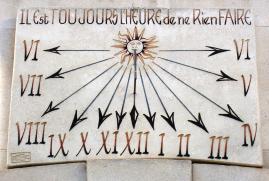
The picture shows a sundial which I photographed in Saint-Rémy-de-Provence in 2004. The caption on the top reads Il Est TOUJOURS L'HEURE de ne Rien FAIRE, meaning "It Is ALWAYS THE TIME to DO Nothing" (don't ask me to explain the bizarre capitalization). Notice our attraction to interesting numbers, even though they are just artifacts of our numbering systems. It being 2011, the date of my birthday this year is abbreviated "1/11/11", which seems mildly amusing.Note 1 My niece-in-law Carolyn attempted to send me a birthday-wishes e-mail message time stamped at 1/11/11 11:11. My children used to watch our digital clocks to see them hit "11:11". Then they would hold their breath, or something like that. Wow, what will happen this coming November, on 11/11/11? I ought to start an internet rumor that the world will end on 11/11/11 at 11:11 (it probably wouldn't take much to get that going). Maybe that's when "The Larry Calendar" expires, perhaps contemporaneously with its namesake. I used to watch my car's odometer for interesting numerical combinations, such as turning over from 99999 to 100000 miles, or palindromes like 123321.
A year is obviously not an arbitrarily chosen unit of time - it's the time it takes the earth to make one revolution around the sun. Even primitive man, before the invention of clocks, was familiar with the idea of a year from watching the passage of the seasons. Similarly, a day is the amount of time it takes for the earth to make one rotation around its axis.Note 2 On the other hand the length of an hour, a minute, and a second are arbitrary. Clearly, it's nice to break a day down into an integral number of hours, but other than that, mankind could have defined these units in any way at all. I think that after the French revolution, it was proposed to change the definitions to divide the full day into 20 hours, with 100 minutes per hour, and 100 seconds per minute. This was part of the general reform of all measurements that became the Metric System, used by most of the world today. But the changes proposed in the measurement of time didn't catch on. The seven-day week is also arbitrary - it could be defined as any number of days, and other societies have used a different number of days. We can define a week to be an even number of days, but there is no reason why a year should turn out to be an even number of days, and indeed, it isn't. A year is about 365.2422 days long. We then need to adjust our calendars to make our years work out in the long run. If we made all our years 365 days long, summer would eventually drift into January. I'm talking northern hemisphere here - in the southern hemisphere, summer is already in January.
When I first arrived at Kronos, the software calendar in the company's initial timeclock product was a complete mess (see my entries Coming to Kronos, and the History of Kronos, part 1 and part 2). As part of our re-write of the clock software, I programmed it to keep track of time as the number of minutes elapsed since January first, 1900. That meant time inside the clock was represented by a single large number, and hence the clock could operate properly no matter what that number represented when expressed as a date, month, year, and century. Inside the software, even the turn of the millennium would pass unnoticed. Of course, the software did have to be able to convert that internal notation to an actual year, month, and date. In doing so, it needed to take into account the different lengths of the various months, which it did by having tables of the month lengths. For convenience, it actually had two such tables, one for common years, and one for leap years, differing only in the length of February. They looked sort of like this: One day, I was reading my copy of the trade magazine "EDN" (originally "Electronic Design News"), and I passed over a short article entitled "Simple routines provide calendar date", by Robert D. Grappel. I glanced briefly at a pair of software subroutines for doing date conversions, which were written in the simple computer language "BASIC", and then I turned the page. But in a second, I did a classic "double take", and turned the page back. It had suddenly struck me that there hadn't been any tables of month lengths in the computer code. How could the program work without knowing the lengths of every month? It turned out that everything can be taken care of by certain tricks of integer arithmetic. And analyzing these tricks revealed that the lengths of our months are a good deal more regular than it might at first seem. We gradually started using the Grappel techniques in our date conversions, and our software got simpler than it had been before. I was rather startled to discover new tricks to deal with something I had been familiar with all my life, and had worked with professionally for six years - the calendar.Note 4 My work to simplify Kronos's internal representation of time was done in 1979, but it became really important 21 years later, with the arrival of the year 2000. The starting point for our year numbering is also arbitrary, having been determined by the early Catholic church's estimate of when Jesus had been born (many modern scholars think they got it wrong, and he was probably born around 4 B.C.).Note 5 Since the position of year 1 was a bit arbitrary, and hence the position of year 2000 is also a bit arbitrary, why should the passage of that year cause any particular problems? The reason is that our arbitrary assignments take on a life of their own, and then can produce problematic side-effects. As Marshall McLuhan put it, "We shape our tools and thereafter our tools shape us." Sure, our years need four digits to be fully specified, but for the most part, in our everyday life, we only work with the last two of these. And this was also done by computer programmers, meaning that there were programs extant in 1999 that potentially might have taken the year 2000, represented internally as "00", to be the year 1900. And that had the potential to cause all sorts of havoc. Thus in the years preceding January 1, 2000, pretty much all software that dealt with dates had to be inspected and tested to be sure it wouldn't collapse on the first. As Vice President - Research and Development at the time, I was put in charge of the Engineering aspects of this work, and it occupied most of my time during 1999. June 22,2012 update: The year 2000 effort was of sufficient interest that it merited additional entries in my memoirs. See the entries Y2K and Y2K (bis), posted in February of 2012. If you can recall the hype surrounding the so-called "Y2K" problem, you might like to read a humorous speech I gave on the subject in 1999. It includes a couple of songs I wrote for the occasion, "The Battle Hymn of Y2K", and a take-off on the depression song "Brother, Can You Spare a Dime?". the speech is reproduced in my blog entries Y2K speech, part 1 and Y2K speech, part 2. Clicking on the last two links will open each in a new window, which you can then just close to get back here. In one more year, I'll be 70. This seems like a milestone to me, because it ends in a zero, even though I know that this is an arbitrary convention as well. That number ends in a zero because we happen to have five fingers on each hand, ten on both hands combined. Thus, we use the "decimal" system of counting, base ten. We have symbols to represent any number of fingers up to nine - these are 1, 2, 3, 4, 5, 6, 7, 8, and 9. But when we use up all the fingers on both hands, we put a one in the next column to the left, indicating "one full pair of [2] hands". We then put a zero (0) in the "fingers" column as a place holder, and we write the number as "10". This method of counting using "Arabic" numerals was a major breakthrough in arithmetic (just try multiplying two Roman numerals).
0 1 2 3 4 5
In "base six" notation, the symbol "10", representing all the fingers on one pair of buttercup's hands, represents the number we call six in the decimal system, and "100" represents the number we call 36 in the decimal system, which is six times six. Count the numbers above from 1 through 100, and you'll see there are 36 of them. When I turn 70 in a year, using base six I'd only be 154 - I won't turn 200 for two more years after that. Hey, that makes me feel better. But my point is that next year wouldn't seem like such a milestone, as it wouldn't end in a zero. I'd have to wait two more years for that, until I turn 200. Counting base six is the only way I'll ever get to 200.
  Note 1: January 11, 2011 is written "1/11/11" in American date shorthand. In Europe, it's generally thought of as "11 January, 2011", and written "11/1/11". This potential confusion is the reason I fully write out the dates in my entries. The same issue caused confusion during World War II, and General Dwight D. Eisenhower solved it in much the same way - he required all dates to be written with a text abbreviation for the month, as in "11 JAN, 1942". My birthday falls on "1/11", and Margie's on "2/22". Perhaps we needed to have a child born on "3/33" - oh, wait, that would be April 2. [return to text] Note 2: Sort of. A point on the earth that starts directly under the sun actually makes one full rotation in about 23 hours 56 minutes. At that point, the earth has made one full turn in space, but it has also moved about a degree along its orbit around the sun. It takes another four minutes for the earth to rotate that additional degree to bring the original point back under the sun. You can find a more elaborate description of the difference between the earth's rotation period and the length of a day at the website of Courtney Seligman, including an informative diagram. [return to text] Note 3: OK, remember that a year is about 365.2422 days long, but most years have only 365 days. The Gregorian Calendar corrects for the difference by inserting an extra day (February 29) into "leap years", every four years (other years are called "common years"). Thus there are 365 X 4 + 1 = 1461 days in four years, making a year 1461/4 = 365.25 days long. But that over-corrects, so the Gregorian Calendar omits a leap year once every century, on years ending in 00. Thus every 100 years have 36525 - 1 = 36524 days, and 36524/100 gives us 365.24 days in a year. You can see that's still not right - it's now a little short. So the calendar puts back a leap year every 400 years. 36524 X 4 + 1 = 146097, and 146097/400 = 365.2425, now a bit over again, but pretty close. And that's it for the Gregorian calendar - by the year 4000, some further adjustment will be needed, but it hasn't yet been agreed upon. [return to text] Note 4: It took me quite a while to figure out how and why the routines worked. Essentially, if you adjust the month codes to pretend that the year starts with March, the month lengths can be taken to come from the series 30, 31, 30, 31, 31, repeating indefinitely, if you shift it into the right place. The sum up to any given point in that series is given by the integer value of 153x/5, as you increase x (the "integer value" is what's left after you throw away any fractional part of the result). By moving the only real oddball month, February, to the end of the "year", you don't need to worry about how many days it has. The guts of the program that computes the number of elapsed days from a past reference point, in the easily readable "BASIC" computer language, is: 10 INPUT "MONTH " ;M
Lines 40 - 60 adjust the month code to 0 - 12 for March through February (and decrement the year for January and February). Line 70 then does all the work in one line (the "+2" shifts the numeric series into the right position under the months, so to speak). This article simplified our date programming from then on. It was printed in the October 17, 1985 issue of EDN magazine, on page 168, and written by Robert D. Grappel. If you want to see a scan of this one page article, which I tore out and kept, click on the following link (in some browsers, you may need to then click on the image to enlarge it): Simple routines provide calendar date. [return to text] Note 5: Since "B.C." means "Before Christ", this at first glance doesn't seem to make any sense. How could Jesus be born four years before his own birth? The answer is actually pretty simple, though. Once the calendar was established based on an early estimate of the year of Jesus' birth, nobody was about to switch it around each time scholars came up with a better estimate. So if it turns out that Jesus was born four years earlier than originally estimated, then on the calendar established by that original estimate, he was born in 4 B.C. The birth of Jesus is not so easy to pin down. The book of Matthew says (Matthew 2:1) that Jesus was born during the reign of Herod the Great, who died in 4 B.C. But the book of Luke says (Luke 2:2) that Jesus was born during the first census in Israel, while Quirinius was governor of Syria. This census took place in 6 AD and 7 AD, about 10 years after Herod's death. A minority of scholars think that Jesus never existed at all. For a good lay exposition of this argument, take a look at the book The Jesus Puzzle, by Earl Doherty. [return to text]
 |
 I turned 69 today, 1/11/11, a day which also marks the first anniversary of this Memoirs and Musings blog. Thus I started thinking about time, and how we measure it - seconds, minutes, hours, days, weeks, months, and years.
I turned 69 today, 1/11/11, a day which also marks the first anniversary of this Memoirs and Musings blog. Thus I started thinking about time, and how we measure it - seconds, minutes, hours, days, weeks, months, and years.
 It seems this odometer-watching tendency can be inherited. Quite some time ago, Margie received (and saved) a text message from our daughter Sara, which read, "My car hit 40,000 miles!" It was accompanied by the cell phone photo on the right. I hope she pulled over to the side of the road before sending this. Texting while driving was legal back then, but that doesn't mean it was ever a good idea.
It seems this odometer-watching tendency can be inherited. Quite some time ago, Margie received (and saved) a text message from our daughter Sara, which read, "My car hit 40,000 miles!" It was accompanied by the cell phone photo on the right. I hope she pulled over to the side of the road before sending this. Texting while driving was legal back then, but that doesn't mean it was ever a good idea.

 To the right is a picture of "Buttercup", a three-toed sloth I photographed in Costa Rica. If we had a total of six digits on our two hands, like Buttercup, we would count "base six" instead of "base ten". Buttercup only needs the digits 1 - 5 to count her fingers, and of course still needs zero as a place holder. Her numbers in order, base six, look like this:
To the right is a picture of "Buttercup", a three-toed sloth I photographed in Costa Rica. If we had a total of six digits on our two hands, like Buttercup, we would count "base six" instead of "base ten". Buttercup only needs the digits 1 - 5 to count her fingers, and of course still needs zero as a place holder. Her numbers in order, base six, look like this: